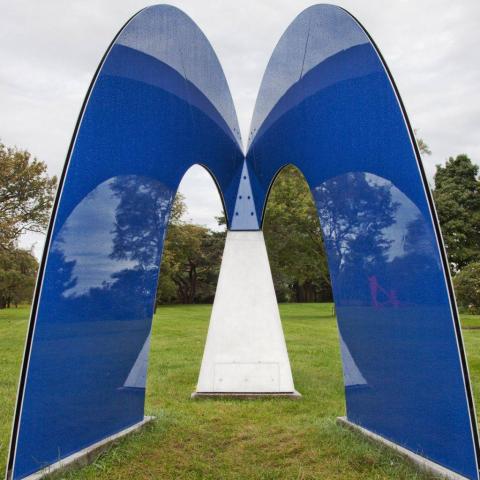Rainbow

Duayne Hatchett credits his grandmother with encouraging his interest in art. Born in Shawnee, Oklahoma in 1925, Hatchett was raised by his grandmother during the Depression. He began his studies at the University of Missouri, but enlisted during World War II and served as a fighter pilot. While in Paris, Hatchett constantly visited the Louvre. Upon his return he enrolled at the University of Oklahoma and received his BFA in 1950 and an MFA in Painting two years later. Hatchett taught at Oklahoma City University, the University of Tulsa, Ohio State University, and the University of Buffalo, where he became head of the sculpture department in 1968, a position he held for twenty-four years.
In the 1950s, Hatchett worked with found materials. The sculptures, influence by his training as fighter pilot—with its emphasis on mathematics and physics--explored the themes of flight and escape from density. In the 1960s, the artist realized that the found materials did not lend themselves to the forms that he felt were necessary for his work. He moved toward Minimalism, working with steel and aluminum. The new materials required Hatchett to plan his work in advance, and he began building models and mock-ups of his sculptures. His sculptures took on the relationship to space, rather than mass. They delved into the juxtapositions created by the different placement of lines and planes, surreptitiously defining spatial volumes. In the 1970s, Hatchett investigated the possible unions among six planes moving through space, discovering that the most exciting composition was compressed and relatively shallow.
Rainbow, created in 1970, belongs to the series of sculptures exploring the definition of volumes in space. The aluminum structure, painted blue, resembles, as the name suggests, two rainbows joined at one end. The sculpture begins as one thick piece, placed on a diagonal, and split apart into space, opening up into a curving gesture that both slices and engulfs the area. The work’s diagonal and curves add movement and energy to the piece. When viewed from a certain angle, the sculpture appears to be fighting with itself, pushing and pulling in opposite directions. The rainbow components further investigate the idea of volume and space. They consist of two planes each with a small void running between the planes. This void, which Hatchett calls a “reveal”, is placed purposefully to add dynamism to the relationship between the planes, as well as between the planes and the space they bisect.
